Glossary
Use the letters A-Z to navigate through the glossary of towing and hitch related terminology below. Knowing these terms will help you to better understand towing, wiring, hitches, installation, saftey and more.
A
Application Guide
A complete listing of current hitch part numbers and the associated vehicle applications.
APV
All Purpose Vehicle
ATV
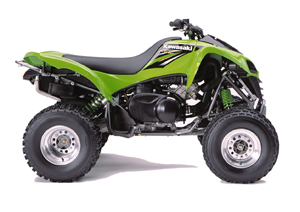
All-Terrain
Vehicle
AWD
All Wheel Drive
Axle
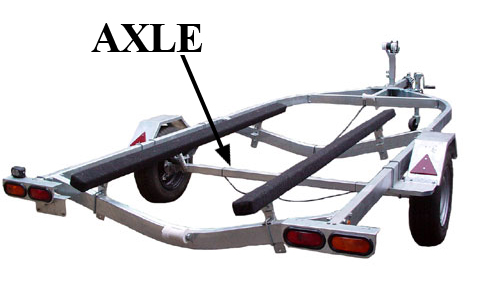
That which attaches wheels to trailer.
B
Ball
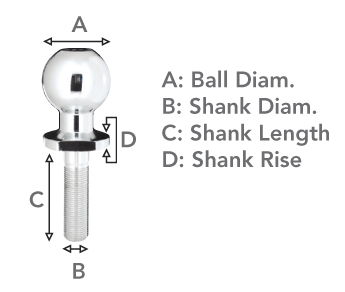
Trailer Ball or Hitch Ball. The ball-shaped attachment to a hitch onto which a trailer coupler is attached. The coupler mounts and locks on top of the hitch ball and articulates around the hitch ball. Recreational and light commercial hitch balls come in a variety of sizes including 1 7/8-inch, 2-inch, 2 5/16-inch and rarely, 3-inch. In general, lighter trailers use smaller hitch balls. While the diameter of hitch balls is fairly standard, shank diameters and the hitch ball weight ratings may differ. The rating of the hitch ball is just as important as the receiver hitch ratings themselves.
Ball Height
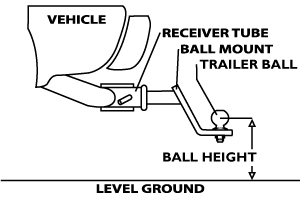
Measurement
from the ground to the center of the hitch ball or hitch ball coupling (trailer)
when parked on a flat surface and parallel to the ground. Used to determine the
amount of drop or rise needed in the ball mount to make the trailer ride
parallel to the ground when being towed. The maximum recommended hitch ball
height for trailers is 25" from the ground measured to the center of the hitch
ball.
Ball Mount
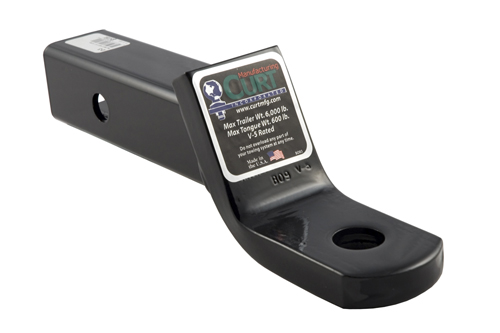
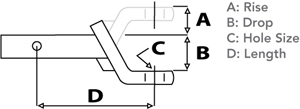
Also known as Drawbar or Hitch Bar. A removable hitch ball platform that slides into the receiver of a hitch and fastens with a pin and clip. Different ball mounts can be used to raise or lower the height of the ball to allow for level trailer towing.
Bolt-on-hitch (fixed tongue)
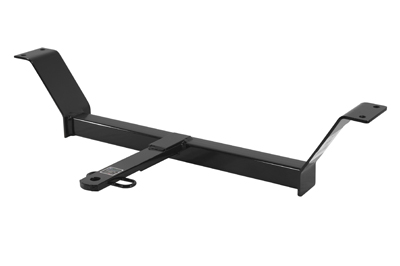
A
device which attaches directly to the tow vehicle providing the connection
between the tow vehicle and the trailer. A fixed tongue hitch includes the ball
platform, while a receiver style hitch has a receptacle (typically 1-1/4" or 2")
for inserting special ball mounts or other accessories.
Brake Controller
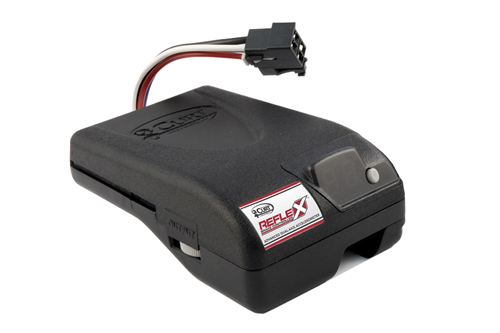
Interface between tow vehicle and electric trailer brakes. Can be inertia activated or based on time delay from activation of vehicle brakes. Typically in the tow vehicle's driving compartment with electrical line running to the trailer wiring connector. Most require the user to adjust brake gain to compensate for varying trailer load. Necessary for the use of electric trailer brakes.
Breakaway Switch
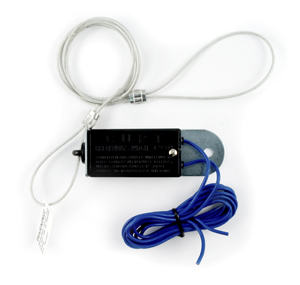
A component within a Breakaway System that is attached to both the tow vehicle and the trailer.
Breakaway System
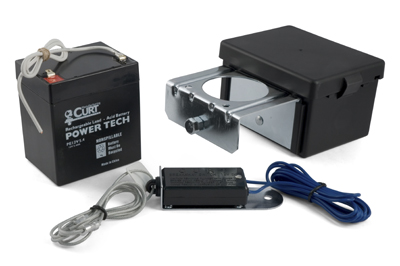
A
safety system that activates the trailer brakes in the event that the trailer
becomes accidentally disconnected from the vehicle while
traveling.
Bumper

The parts on a vehicle that protect the front and rear ends in the event of an accident. Some trucks and SUVs have a tow bumper (or step bumper) for attaching a hitch ball for towing. See Quick Reference Chart of Bumper Styles.
Bumper Hitch
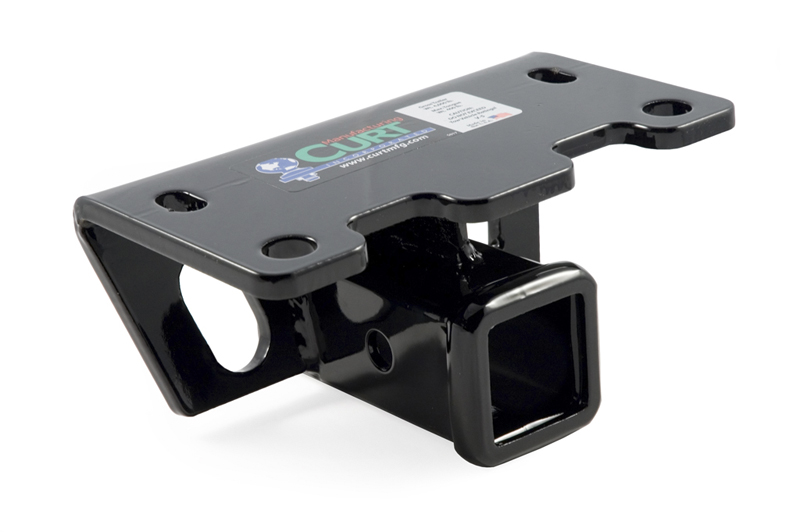
A receiver style hitch that attaches a vehicle's bumper.
Bumper Pull Trailer
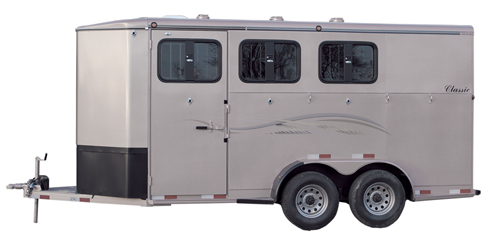
A trailer that is pulled behind a vehicle with a chassis mounted trailer hitch as opposed to a Fifth-Wheel or Gooseneck. Also called a tag-along trailer.
Bungee Cords
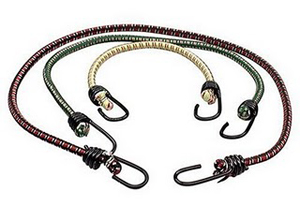
Cords
composed of rubber or several elastic strands covered with nylon or cloth and
have metal or plastic hooks on each end. These are available in nearly any
length are best used to secure light weight items.
C
Cargo Carrier

The cargo carrier is a hitch mounted platform that typically has up to a 500lb weight capacity. Common uses include hauling coolers, boxes, tools, firewood, and other items unable to fit into your vehicle. They are usually offered with a small 2" wall or a higher 6" wall and may include a tilt feature allowing the carrier to fold up when not in use.
Chassis
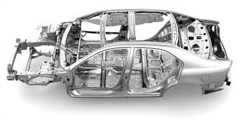
The main structure of a vehicle. Can be a uni-body or C-frame construction.
Class 1 (Class I) Hitch
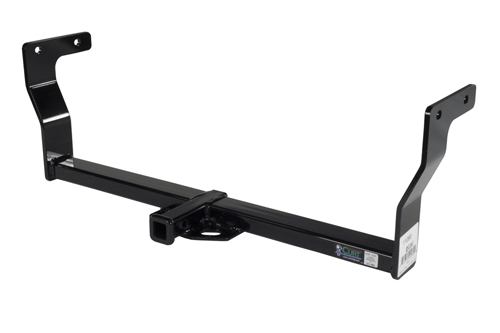
Trailer hitch with capacity of up to 2,000 lbs gross trailer weight and 200 lbs tongue weight. Typically has a 1-1/4" receiver tube.
Class 2 (Class II) Hitch
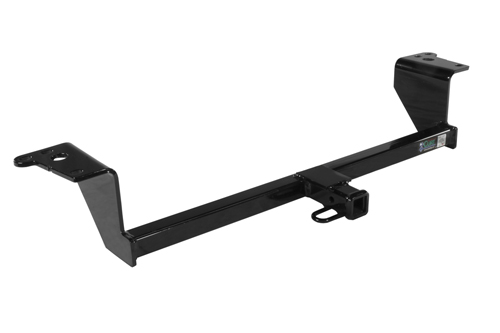
Trailer hitch with weight-carrying rating of up to 3,500 lbs gross trailer weight and 300/350 lbs tongue weight. Typically has a 1-1/4" receiver tube.
Class 3 (Class III) Hitch
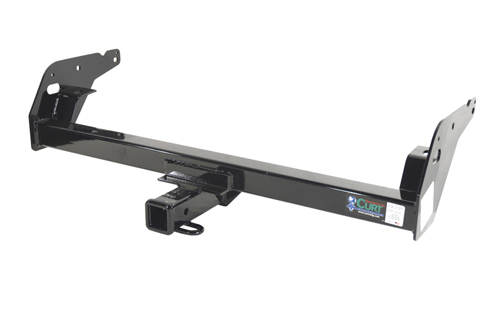
Trailer hitch with weight carrying rating of up to 6,000 lbs gross trailer weight and 600 lbs tongue weight. Sometimes used to refer to a hitch with a 2" receiver, regardless of rating.
Class 4 (Class IV) Hitch
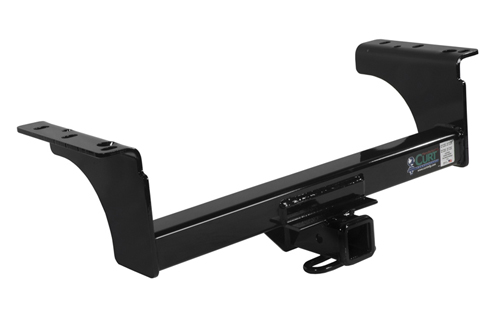
Trailer hitch with weight carrying rating of up to 10,000 lbs gross trailer weight and 1,000 lbs tongue weight. Although many times any hitch with a capacity greater than 6,000 lbs gross trailer weight is referred to as a Class 4.
Class 5 (Class V) Hitch
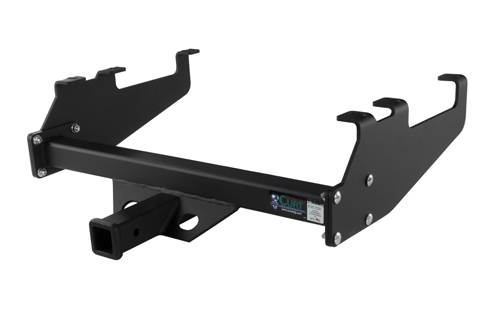
Any trailer hitch with capacity greater than 10,000 lbs. gross trailer weight and 1,000-1,200 lbs. tongue weight. Usually a 2” receiver or in some special cases a 2.5” receiver.
Clip
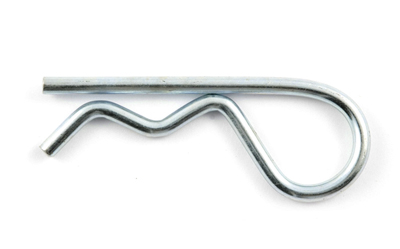
Used to retain the pin in a receiver style hitch.
Color Hitch

Custom hitch, colored to match vehicle, by CURT Manufacturing.
Connector
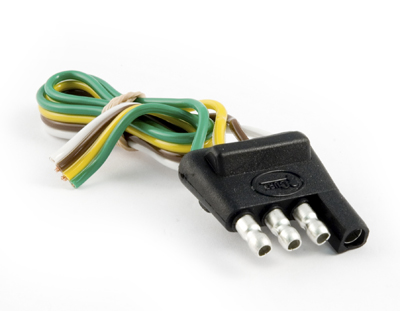
Electrical term used to define components for joining wires.
Converter (Tail Lamp)
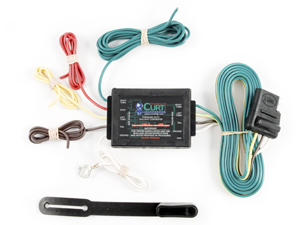
Converts
3-wire tow vehicle electrical systems to 2-wire systems, integrating the stop
and turn signal circuits as is common in trailer wiring.
Coupler
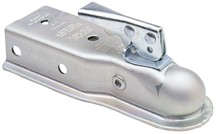
The forward most part of a trailer tongue that envelopes and secures to the tow vehicle hitch ball.
Coupler Height
The distance from the ground to the bottom of the trailer coupler with the trailer tongue leveled. The Coupler Height and Hitch Height are used to determine the drop or rise needed when selecting a ball mount.
Coupler Lock
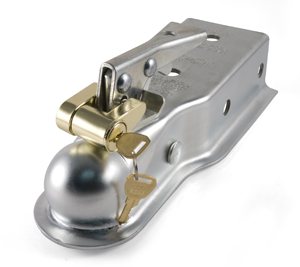
A
pin style lock designed to fit through the coupler's latching mechanism
disabling it from latching on to, or being removed from, the ball. This,
in turn, prevents unwanted use or removal of the trailer.
Crossover
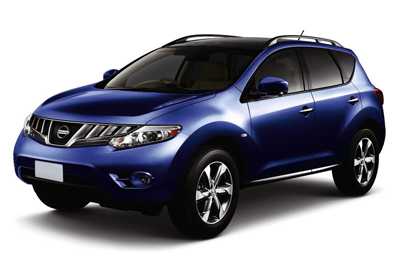
Also
called "Crossover Utility Vehicle (CUV)". A vehicle built on a car
platform, but uses styling and features common on Sport Utility Vehicle's
(SUV's).
Curb Weight
Curb Weight is the total weight of a vehicle with OEM equipment and all necessary fluids, (water, coolant, or oil) a full tank of gas, minus passengers or cargo.
Custom Hitch
A hitch that is designed for a particular year, make and model of vehicle. Because these hitches are made for a specific vehicle, the best possible appearance can be achieved.
CUV

Crossover
Utility Vehicle. Also called "Crossover".
D
Dinghy
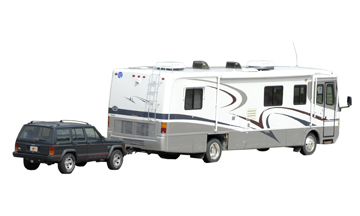
A vehicle towed behind a motorhome, sometimes with two wheels on a special trailer called a tow dolly, but often with all four wheels on the ground.
Drawbar
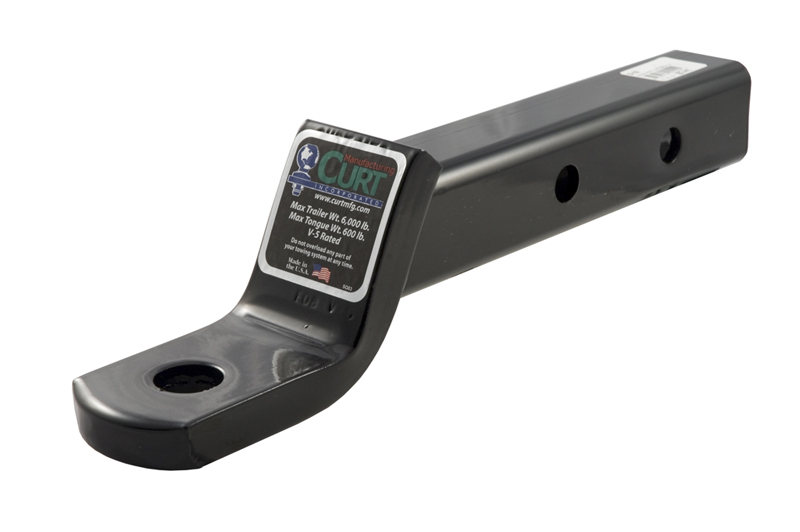
A
removable hitch ball platform that slides into a hitch receiver and fastens with
a pin and clip, or the "tongue" portion of a fixed-tongue hitch. The term
drawbar is sometimes used to distinguish a ball mount or a coupling
configuration different than a hitch ball (such as a pintle hook). Also see:
Ball Mount.
Dry Weight
Dry Weight is a technical term that refers to the weight of an automobile or trailer without any fluids (water, coolant, oil, or gas), passengers or cargo.
Dually
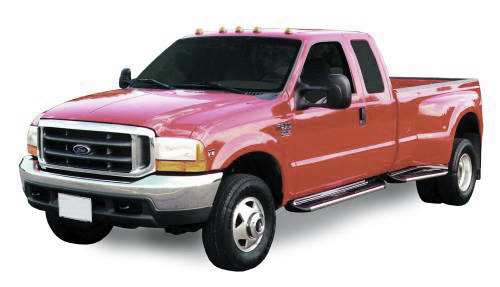
A pickup truck, or light-duty tow vehicle with 4 tires on one rear axle.
E
Equalizer
Sometimes this term is used for “weight distribution system”. A hitch system built around a receiver hitch, which includes supplemental equipment such as spring bars that can be placed under tension to distribute trailer tongue loads to the trailer axle(s) and the tow vehicle front axle. Use of a weight distribution system enhances handling and braking while increasing trailer towing capacity. Weight distributing hitches currently come in two configurations: one with square bars that hook to the center of the ball mount, called trunnion bars; and one with round bars that slide into the bottom of the ball mount, called round bars.
F
Fifth Wheel Hitch
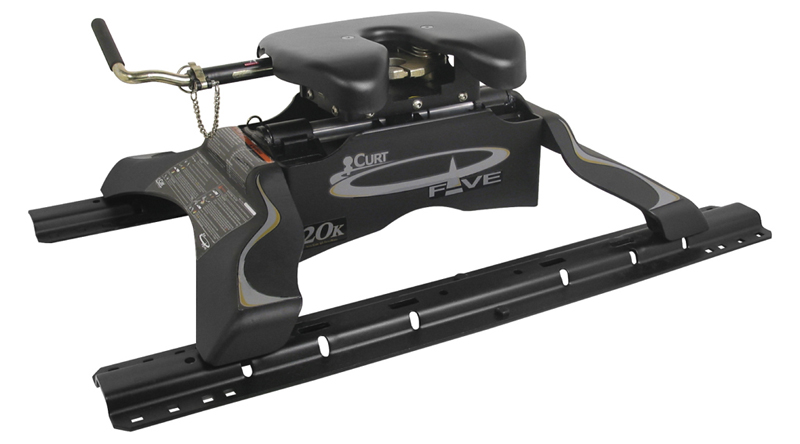
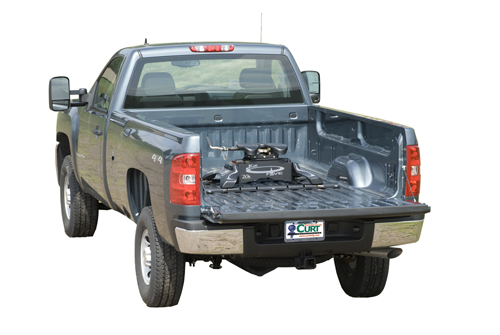
A heavy duty Class 5 hitch that mounts in the bed of pickup truck which uses a plate in the bed of the truck (similar to a semi-tractor) and a pin on the trailer.
Fifth Wheel Trailer
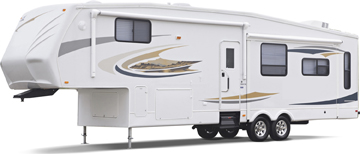
Fifth wheel trailers are trailers designed to be coupled to a special hitch that is mounted over the rear axle in the bed of a pickup truck. These trailers can have one, two or three axles and are the largest type of trailer built. Because of their special hitch requirements, fifth wheel trailers can only be towed by trucks or specialized vehicles prepared for fifth wheel trailer compatibility.
Fishwire
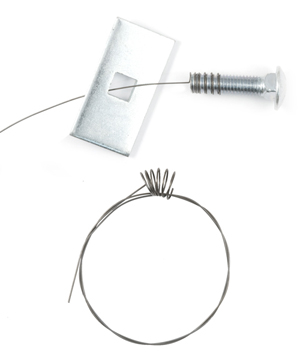
A fishwire is a small wire device that allows you to "fish" or pull hardware through an enclosed frame or bumper tube.
Fixed Tongue Hitch

A hitch with an integral ball platform (tongue) that cannot be removed. Also see: custom hitch, hitch, receiver hitch, and round tube hitch.
Four Wheel Drive
4WD - Four Wheel Drive
Frame
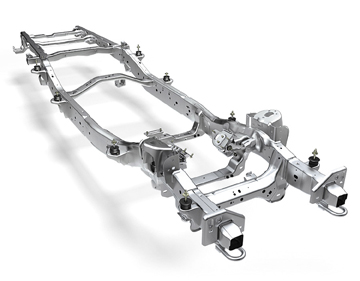
The part of a vehicle which all other parts attach to.
Frame Mount Hitch
Hitches that are designed to be bolted to the vehicle frame or cross members. This type of hitch may have a permanent ball mount, or may have a square-tube receiver into which a removable hitch bar or shank is installed.
Front Mount Hitch

A
2" receiver hitch that mounts to the frame at the front of the vehicle and is
available for several trucks, full-sized vans, and SUV's. This provides a
convenient mount for hitch accessories. Front mount hitches can also be
used for easy maneuvering at the boat launch or campground.
FWD
Front wheel drive.
G
GAW - Gross Axle Weight
The total weight supported by each vehicle's axle (front or rear.)
GAWR - Gross Axle Weight Rating
The manufacturer's rating for the maximum allowable weight that an axle is designed to carry. GAWR applies to tow vehicle, trailer, fifth-wheel and motorhome axles.
GCW or GCVW - Gross Combined (Vehicle) Weight
The actual total combined weight of a vehicle and trailer, including all passengers and payload.
GCWR - Gross Combination Weight Rating
The maximum allowable weight of the combination of tow vehicle and trailer/fifth-wheel, or motorhome and dinghy. It includes the weight of the vehicle, trailer/fifth-wheel (or dinghy), cargo, passengers and a full load of fluids (fresh water, propane, fuel, etc.)
Gooseneck Hitch
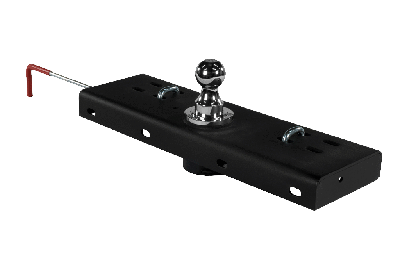
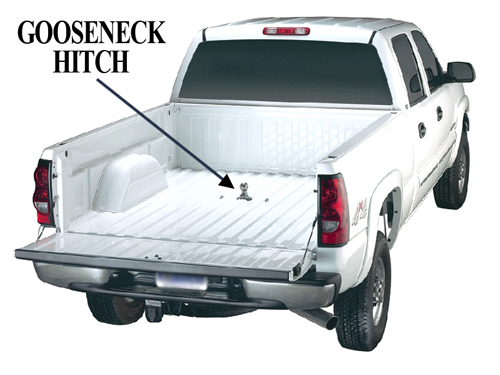
A towing system that mounts a ball in the bed of a pickup truck (either 2-5/16" or 3" in diameter) to engage a coupler on a trailer.
Gooseneck Trailer
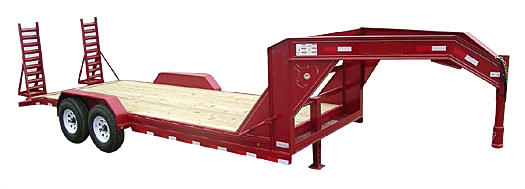
A gooseneck trailers derives its name from its shape. A gooseneck trailer typically uses a ball and socket coupling, kingpin or other similar trailer connection method located above and forward of the rearmost axle of the towing vehicle.
GTW - Gross Trailer Weight
The total weight of the trailer fully loaded in its actual towing condition.
GVW - Gross Vehicle Weight
The total weight of a vehicle when fully loaded, including all of its contents and passengers.
GVWR - Gross Vehicle Weight Rating
The total weight of a vehicle, specified by a manufacturer, as the recommended weight when fully loaded, including passengers, cargo, and fluids.
H
Handle Nuts
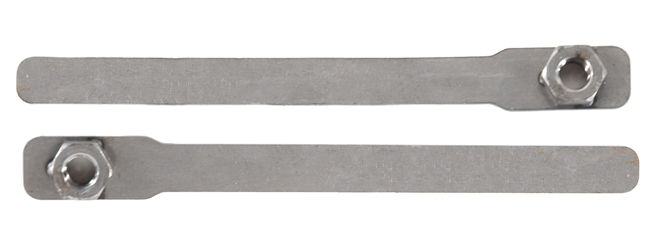
Handle nuts are designed to be and in-frame mounting point which can be inserted from an access hole, or other hard to reach places.
Handwheel
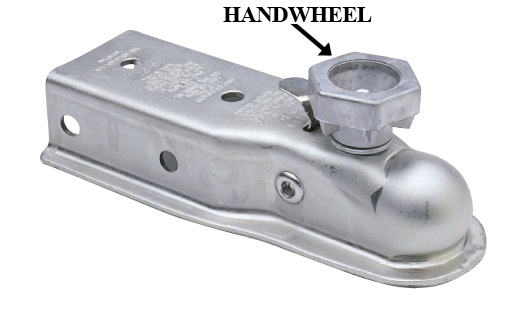
The threaded turnable wheel on top of a trailer coupler that tightens or loosens the coupler assembly around the hitch ball.
Hard Top

A removable metal or fiberglass rigid structure that fastens to a vehicle and encloses the occupant compartment.
Hitch
A device which attaches directly to a tow vehicle providing the connection between the tow vehicle and the trailer. Hitch installations are most often considered permanent. A fixed tongue hitch includes a flat non-removable drawbar, while a receiver style hitch has a receptacle (typically 1-1/4" or 2") for inserting special ball mounts or accessories.
Hitch Adapter
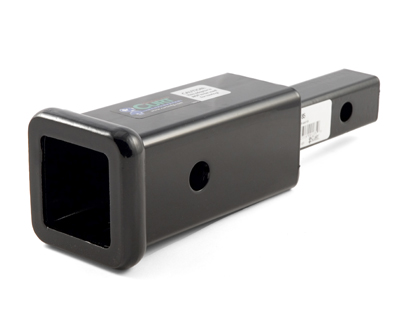
An
item that fits into the receiver tube of a hitch and converts it from a 1 1/4"
receiver to a 2" receiver, or from a 2" receiver to a 1 1/4". Using a
hitch adapter may reduce the overall capacity to the rating of the adapter being
used.
Hitch Ball

Ball or Trailer Ball. The ball-shaped attachment to a hitch onto which a trailer coupler is attached. The coupler mounts and locks on top of the hitch ball and articulates around the hitch ball. Recreational and light commercial hitch balls come in a variety of sizes including 1 7/8-inch, 2-inch, 2 5/16-inch and rarely, 3-inch. In general, lighter trailers use smaller hitch balls. While the diameter of hitch balls is fairly standard, shank diameters and the hitch ball weight ratings may differ. The rating of the hitch ball is just as important as the receiver hitch ratings themselves.
Hitch Bar

Also know as “Ball Mount” or “Drawbar”. A removable hitch ball platform that slides into the receiver of a hitch and fastens with a pin and clip. Different ball mounts can be used to raise or lower the height of the ball to allow for level trailer towing.
Hitch Class
Defines receiver tube size and weight rating capacity for receiver style hitches.
Hitch Extender
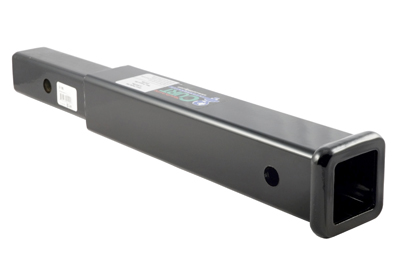
An
item that fits into the receiver tube of a hitch can extend the receiver tube
several inches. Using a hitch extension may reduce the overall capacityto
the rating of the extender being used.
Hitch Height
The distance from the ground to the top of the hitch receiver tube, with the vehicle parked on level ground. The Hitch Height and the Coupler Height are used to determine the drop or rise needed when selecting a ball mount.
Hitch Lock
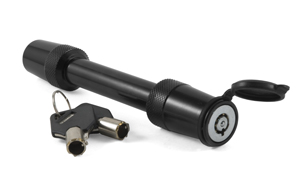
A
locking pin designed to secure a ball mount or other hitch mounted accessory to
the hitch, preventing theft.
Hitch Pin

Also called a Pin or Receiver Pin, holds the ball mount in the hitch. It is also a convenient attachment point for breakaway cables. Typically, a Hitch Pin is bent like a hockey stick, and drilled at one end to accept a hairpin-shaped retaining clip.
Hitch Ratings
Hitches are rated by the manufacturers according to the maximum amount of weight they are engineered to handle. See Class 1 - 5 hitch.
Hitch Weight
Also known as “Tongue Weight”. The downward weight applied by the towable equipment on the hitch ball. Generally travel trailer tongue weight should not be more than 10% of the gross trailer weight.
I
Insert
Any item that slides into a receiver style hitch (i.e. ball mount, bike rack, or winch.)
J
Jackknife
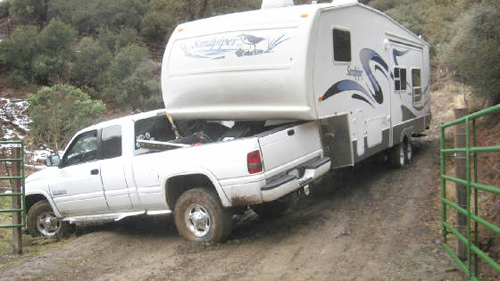
An extreme turning maneuver that risks damage to the tow vehicle and the trailer occurs when the trailer swings into contact with the tow vehicle. Jackknife accidents usually occur while backing up.
K
Kingpin
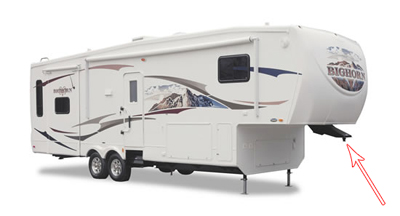
The
point at the center of a fifth wheel trailers nose which is captured by the
locking bar or jaws of a fifth wheel hitch. The circular shape of the
kingpin allows the trailer to rotate freely within the fifth wheel hitch to
allow for proper turning and maneuvering.
L
Landing Gear
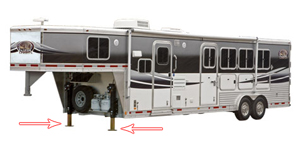
Commonly
used on Gooseneck & Fifth Wheel trailers to stabilize the trailer when not
in tow. Landing Gear is also used to raise and lower the trailer height
when coupling and uncoupling. Always be sure to completely raise the
landing gear before towing.
LB
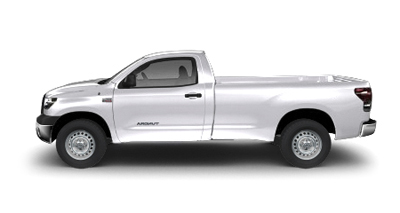
Long Bed – pickup truck or van - usually 8 foot truck bed.
LED
Light Emitting Diode
Locking Pin
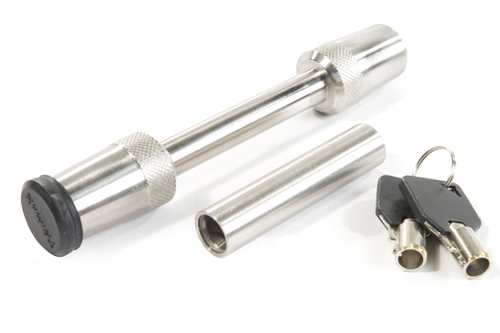
A hitch pin that locks with a key to prevent theft of a ball mount or other insert.
Lunette Eye
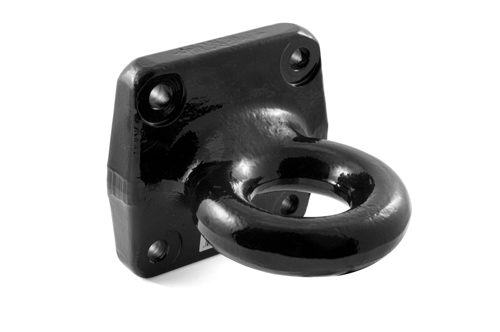
A round metal ring used in place of a ball coupler on a trailer. It attaches to a pintle hook on the towing vehicle.
O
OEM
Original Equipment Manufacturer.
P
Payload
The transported load. Freight, excluding the weight of the trailer or tow vehicle.
Pin

Also called a Hitch Pin or Receiver Pin, holds the ball mount in the hitch. It is also a convenient attachment point for breakaway cables. Typically, a Pin is bent like a hockey stick, and drilled at one to accept a hairpin-shaped retaining clip.
Pintle Hitch
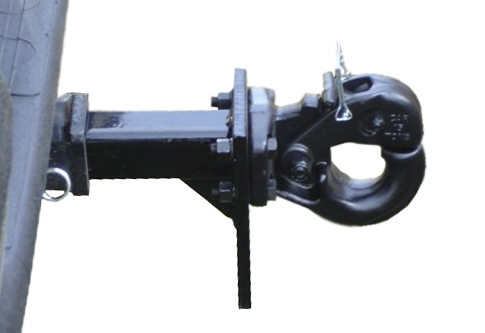
A common heavy-duty coupling type which utilizes a pintle hook attached to a tow vehicle to pull a trailer having a lunette eye. Pintle hitches are commonly used on military, construction, industrial and agricultural equipment.
Pintle Hook
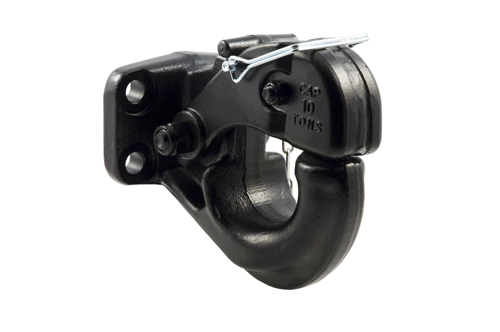
The "jaw" portion of a pintle hitch which attaches to the tow vehicle.
Pintle Mount
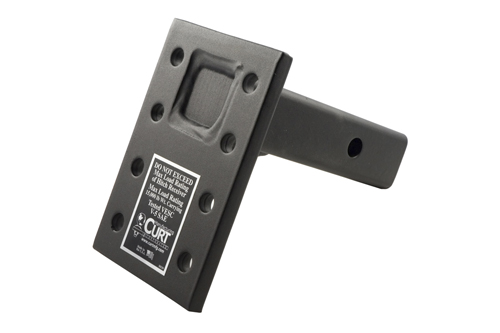
An insert for a receiver hitch, having a shank with a flat plate. These mounts are typically adjustable for vertical height.
Plug
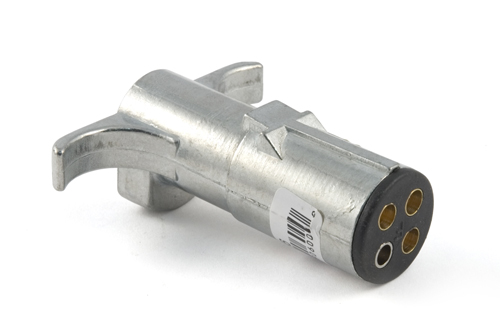
The connector used to connect trailer wiring to a tow vehicle. Plug refers to the trailer end of the connection. Socket refers to the car end.
Powered Converter (Tail Lamp)
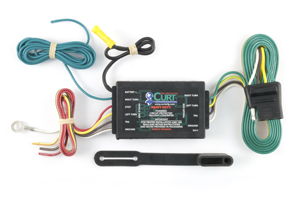
Converts
3-wire tow vehicle electrical systems to 2-wire systems, intergrating the stop
and turn signal circuits as is common in trailer wiring. This converter
will be powered by the vehicle battery, allowing the trailer lights to be
illuminated with virtually no draw on the vehicle tallight circuit.
Powered converters are recommended on most vehicles with LED
taillights.
PWC
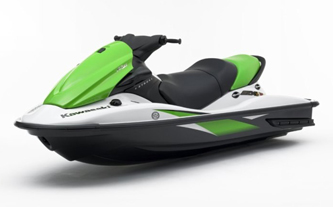
Personal
Water Craft
PWM
Pulse Width Modulation
R
Ratchet Strap
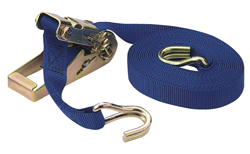
A
nylon strap attached to ratcheting assembly designed to secure cargo. The
ratcheting assembly allows the strap to be tightened, eliminating the unwanted
movement of a load. Ratchet straps typically have metal hooks on each
end.
Receiver Cover
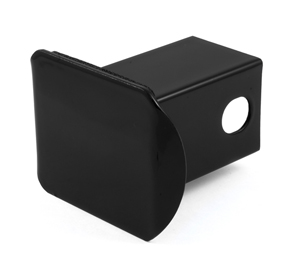
A temporary receiver end-cap insertable into a 1-1/4" or 2" hitch receiver. Designed to protect the receiver tube from the elements. Also used to mask or enhance the look of the hitch when not in use.
Receiver Hitch
Any hitch with a receptacle (typically 1-1/4" or 2") which accommodates inserts such as drawbars, ball mounts, or bike racks.
Receiver Pin

Also
called a Hitch Pin or Pin, holds the ball mount in the hitch. It is also
convenient attachment point for breakaway cables. Typically, a Receiver
Pin is bent like a hockey stick, and drilled at one end to accept a
hairpin-shaped retaining clip.
Receiver Tube
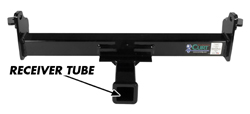
The receptacle part of a trailer hitch which accommodates inserts such as ball mounts, drawbars or accessory carriers. Common receiver sizes are 1-1/4" and 2".
Roll Pan
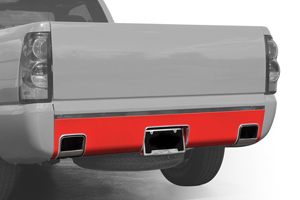
A fascia panel used in place of a rear bumper (common on lowered trucks). Installation of a roll pan may interfere with placement of a bolt-on hitch.
Round Bar
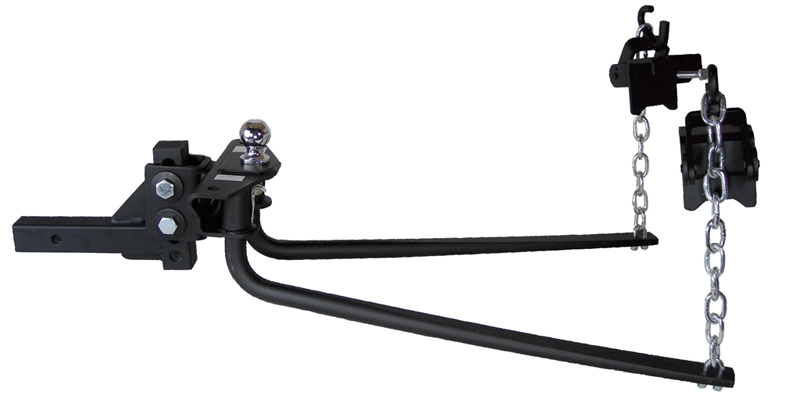
A type of weight distributing hitch that has round bars that slide into the bottom of the ball mount, vs. trunnion style which has square bars that hook to the center of the ball mount.
Round Tube Hitch
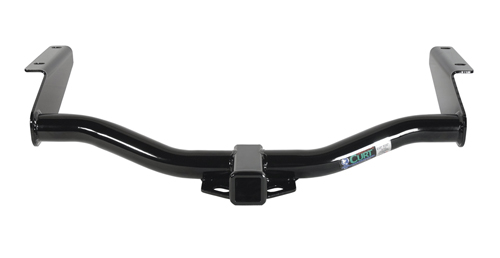
A new generation of custom hitches designed to produce a more pleasing visual appearance. The use of round tubing lowers the weight of the hitch while maintaining its strength. These hitches are designed to complement the look of the vehicles for which they are made.
RWD
Rear wheel drive.
S
Safety Chains
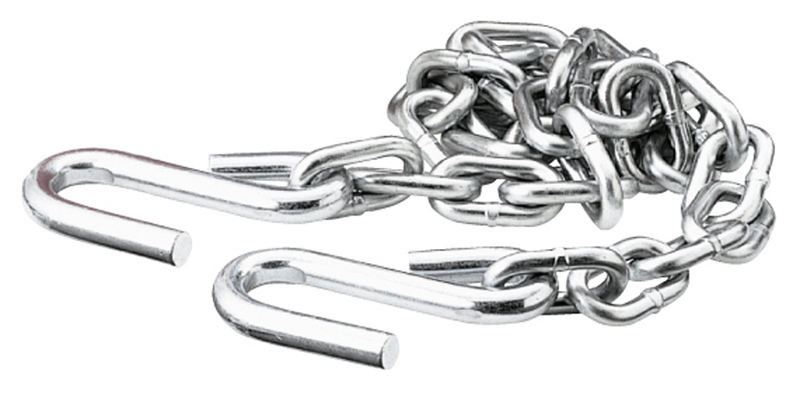
The chains that are attached to the trailer tongue with hooks on their free ends. These chains keep the trailer connected to the tow vehicle should the coupler or hitch ball detach from the tow vehicle. Safety chains must be secured every time you tow.
SB
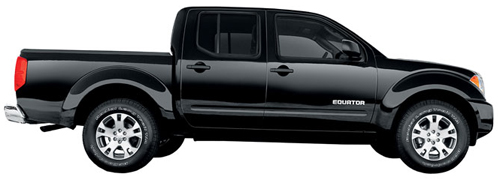
Short Bed – pickup truck or van - usually 6 foot truck bed.
Shank
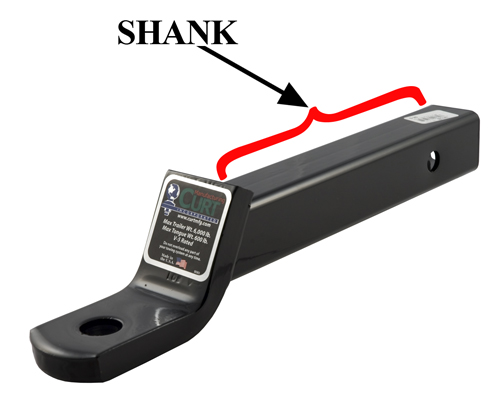
Part of the insert that slides into the receiver hitch.
Socket

Wiring connector used on the CAR end of a trailer wiring connection. The plug is the end used on the trailer.
Spring Bar
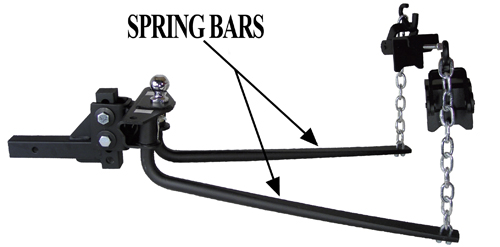
Key component of a weight-distributing hitch system. Spring bars work to distribute trailer tongue loads to the tow vehicle forward axle.
Stabilizing Strap
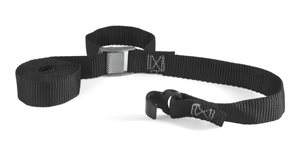
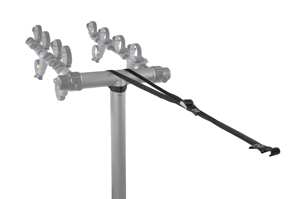
Auxiliary
strap used for added support to unsupported loads such as a bike rack or cargo
carrier.
Sub-Frame
The part of the vehicle which supports the engine and front suspension on a uni-body vehicle.
Surge Brake System
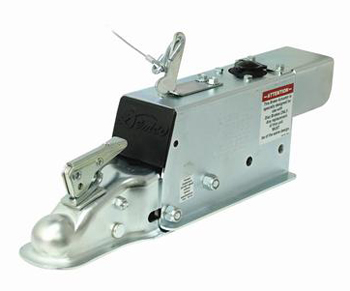
A surge brake system is entirely self-contained on the trailer and is activated when the tow vehicle decelerates. The momentum of the trailer pushes the surge brake housing forward. This drives the push rod that is connected to the coupler into the master cylinder. Brake fluid is then forced out of the master cylinder into the wheel cylinders or pistons that apply the trailer brakes. The entire activation process is completed in less than one second. Hydraulic surge brake systems can be used by a variety of tow vehicles and can accommodate a variety of trailer loading conditions without requiring any type of adjustment.
SUV
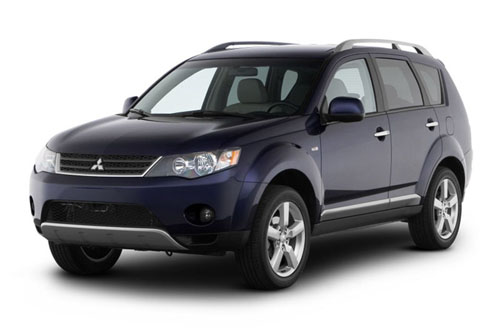
Sport Utility Vehicle.
Sway
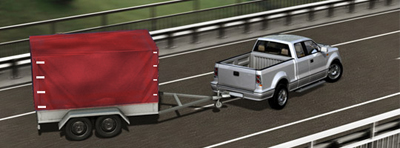
Refers to the “fish-tailing” action of a trailer caused by external forces that set the trailer’s mass into a lateral motion. The trailer’s wheels serve as the axis or pivot point. Also known as “yaw”.
Sway Bar
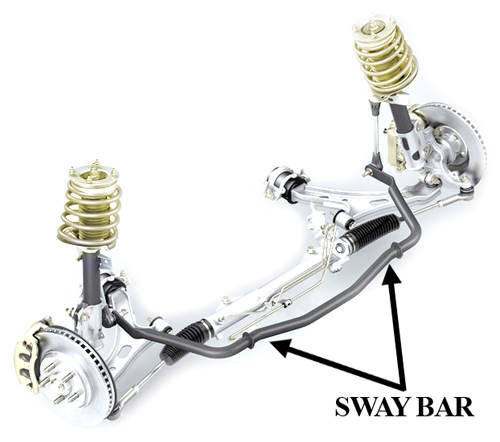
A specialized spring which is part of the suspension on a vehicle. NOT part of a trailer hitch. Sometimes confused with a weight distributing hitch.
Sway Control Device
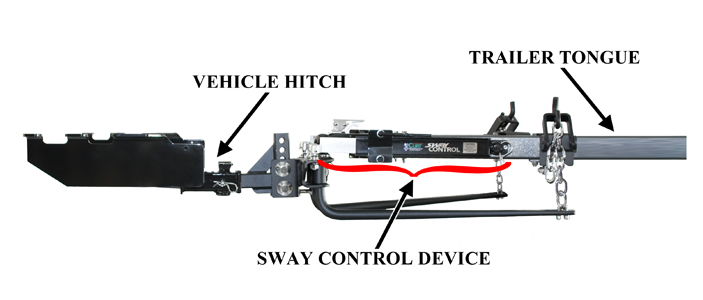

A device which goes between a weight distributing ball mount and a trailer to reduce the likelihood of sway caused by passing vehicles and wind. This device should not be used to correct sway caused by improper tongue weight (too little or too much.)
T
Tandem Axle
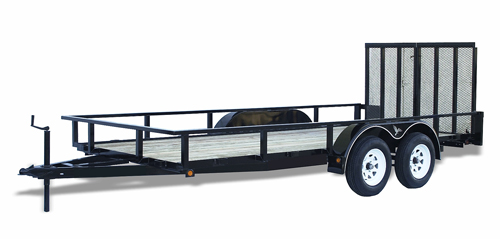
Two fixed axles (four wheels)
T-Connector
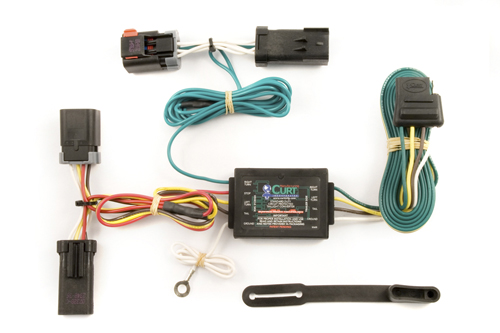
Application specific wiring harness to make trailer wiring ready to plug into towing vehicle.
Tow Bar
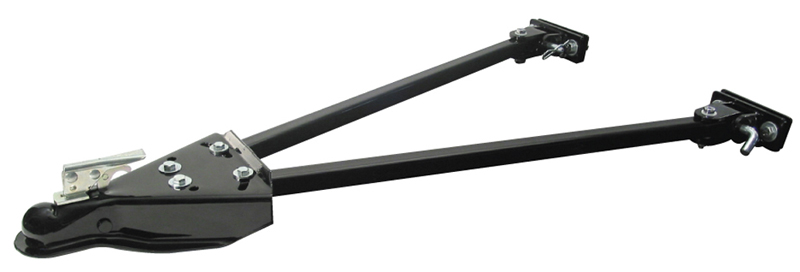
A device attached to the front of a vehicle which allows it to be towed by another vehicle while riding on its own wheels.
Tow Rating
The manufacturer's rating of the maximum weight limit that can safely be towed by a particular vehicle. Tow ratings are related to overall trailer weight, not trailer size, in most cases. However, some tow ratings impose limits as to frontal area of the trailer and overall length. Tow ratings are determined by the vehicle manufacturer according to several criteria, including engine size, transmission, axle ratio, brakes, chassis, cooling systems and other special equipment.
Tow Vehicle
The vehicle that pulls a trailer or towed vehicle.
Trailer Ball

Ball or Hitch Ball. The ball-shaped attachment to a hitch onto which a trailer coupler is attached. The coupler mounts and locks on top of the hitch ball and articulates around the hitch ball. Recreational and light commercial hitch balls come in a variety of sizes including 1 7/8-inch, 2-inch, 2 5/16-inch and rarely, 3-inch. In general, lighter trailers use smaller hitch balls. While the diameter of hitch balls is fairly standard, shank diameters and the hitch ball weight ratings may differ. The rating of the hitch ball is just as important as the receiver hitch ratings themselves.
Trailer Brakes
Brakes that are built into the trailer axle systems and are activated either by electric impulse or by a surge mechanism. The overwhelming majority of RVs utilize electric trailer brakes that are actuated when the tow vehicle's brakes are operated, or when a brake controller is manually activated. Surge brakes utilize a mechanism positioned at the coupler that detects when the tow vehicle is slowing or stopping and activates the trailer brakes via a hydraulic system.
Trailer Electrical Adapter
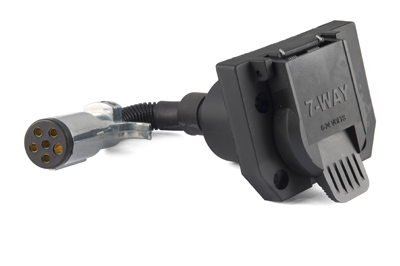
Converts
the car side trailer connector to a compatible mate for the trailer connector.
(i.e. 4-flat to 7-way RV or 6-way round to 7-way RV)
Trailer Jack
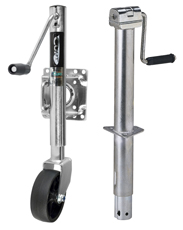
A
device used for supporting, raising, and lowering the trailer
tongue.
Trailer Lock
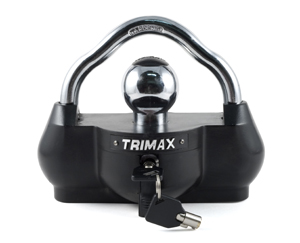 |
|
A
lockable simulated ball assembly intended to prevent unwanted trailer use or
theft.
Trailer Tongue
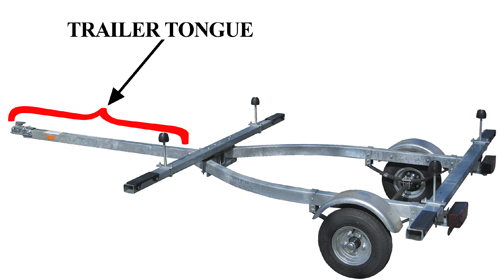
The part of the trailer which extends forward from the trailer box and includes the coupler.
Transmission Cooler
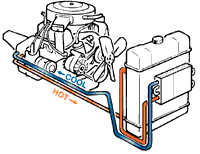
An auxiliary cooler that is available to provide extra cooling for automatic transmission fluid. Lower temperatures equal longer transmission life.
Travel Trailer
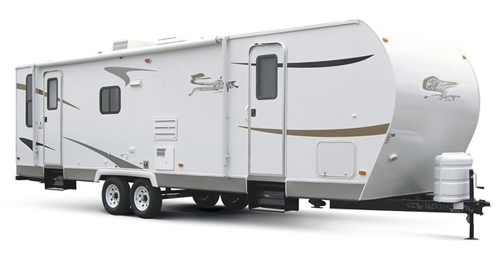
Also known as conventional trailers. These types of trailers have an A-frame and coupler and are attached to a ball mount on the tow vehicle. Travel trailers are available with one, two or three axles.
Tri-Axle

Three fixed axles – 6 wheels.
Trunnion
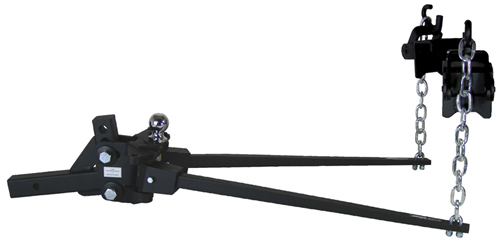
A type of weight distributing hitch that has square bars that hook to the center of the ball mount, vs. round bars that slide into the bottom of the ball mount.
TW - Tongue Weight
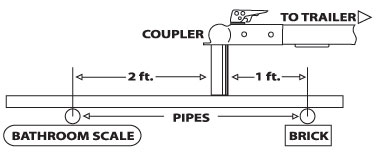
The downward weight applied by the towable equipment on the hitch
ball. Generally tongue weight should not be more than 10% of the gross
trailer weight. To measure the tongue weight, use either a commercial
scale or a bathroom scale with the coupler at towing height. When using a
bathroom scale with heavier tongue weights, use the method shown and
multiply the scale reading by 3.
Two Wheel Drive
2WD - Two Wheel Drive
U
Uni-Body
A vehicle that has frame and body integral. Usually has a sub-frame for the front end which mounts the engine and suspension.
Universal Hitch
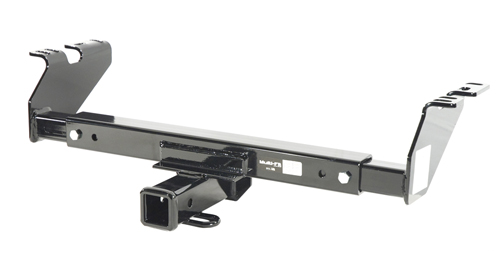
Also known as a “multi-fit hitch” - fits a number of different vehicles.
V
V-5
A minimum testing/rating system of trailer hitches established by the Trailer Hitch Manufacturers Association.
VIN
Vehicle Identification Number.
W
WB
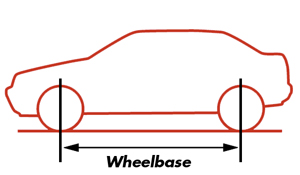
Weight Carrying
A towing situation whereby all of the tongue weight is carried directly on the rear of the tow vehicle and on the hitch.
Weight Carrying Hitch
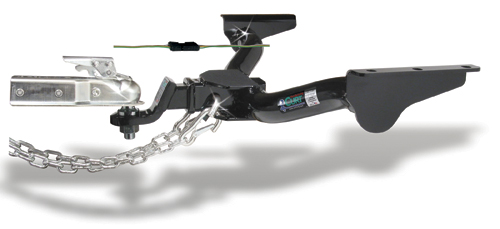
Any hitch used without a weight-distributing system. Some hitches are designed and clearly marked "weight carrying only". Some hitches are weight carrying with weight distributing ability and will have a dual rating – "weight carrying (WC) 5000 / weight distributing (WD) 10,000", for example. To use a hitch at the higher rating (WD), a weight distribution system must be added.
Weight Distributing

A towing situation whereby some or all of the tongue weight is redistributed by use of a weight distributing attachment through the vehicles chassis from the rear axle to the front.
Weight Distribution Hitch
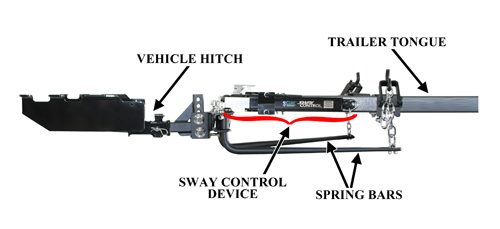
A hitch system built around a receiver hitch, which includes supplemental equipment such as spring bars that can be placed under tension to distribute trailer tongue loads to the trailer axle(s) and the tow vehicle front axle. Use of weight distribution system enhances handling and braking and increases trailer towing capacity. Weight distributing hitches currently come in two configurations: one with square bars that hook to the center of the ball mount, called trunnion bars; and one with round bars that slide into the bottom of the ball mount, called round bars.
Weldnuts
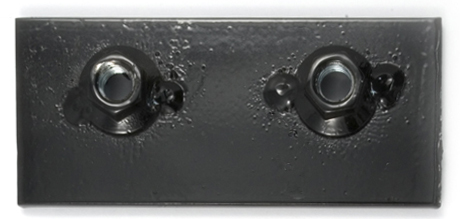
Nuts welded to vehicle frame or their installation plates.
Wiring Harness
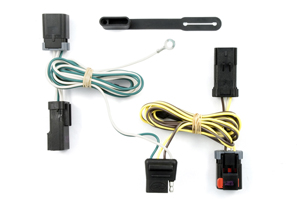
Electrical wiring setup for a vehicle.
Wiring System
Type of wiring configuration, 2 or 3 wire, based on the vehicle.




